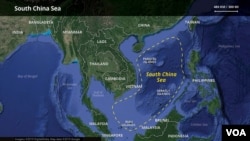China is holding a month of military exercises in a contested sea to show Western powers they can’t control the sensitive waterway and that other Asian maritime claimants should avoid relying on U.S. help in the sovereignty dispute, analysts in the region say.
The Maritime Safety Administration in Beijing announced last month that the exercises would run from March 1-31 in the South China Sea. They will take place in a “circular zone” with a radius of five kilometers west of China’s Leizhou Peninsula between Hong Kong and Vietnam, the administration said on its website.
China’s unusually long-lasting exercises answer 10 “Freedom of Navigation Operations” passages of U.S. naval ships through the 3.5 million-square-kilometer sea last year and one last month, experts believe.
They say Chinese officials feel extra urgency because France, the United Kingdom and possibly other Western allies are sending ships too. Western governments make no claims to the sea itself but worry that China has gone too far in extending its maritime reach, alarming their own citizens.
“It’s a tit for tat between the two sides and the other side is getting a bit crowded nowadays,” said Oh Ei Sun, Southeast Asia-specialized senior fellow with the Singapore Institute of International Affairs. It’s unusual, he said, that European countries would jump into the fray.
The sea that’s rich in fisheries and undersea fossil fuel reserves extends from Hong Kong to the island of Borneo. Six governments claim all or parts of it as their own: Brunei, China, Malaysia, the Philippines, Taiwan and Vietnam. China has taken a lead in the dispute by landfilling tiny islets and placing military equipment on some.
China claims about 90% of the sea based on historical usage records. Chinese coast guard vessels, survey ships and fishing fleets have alarmed Malaysia, the Philippines and Vietnam by passing near their coastlines.
In January, a British defense official said the U.K.’s flagship aircraft carrier strike group was ready to enter the South China Sea, and a Canadian navy warship sailed near the sea in January to join exercises nearby with Australian, Japanese and U.S. navies. Last month France dispatched an attack submarine to the South China Sea.
In the latest gesture, German officials said on March 2 a frigate would head for Asia in August and become the European country’s first warship to cross the South China Sea in nearly 20 years.
China intends to “show resolve” and readiness for Western ships by holding exercises this month, said Aaron Rabena, research fellow at the Asia-Pacific Pathways to Progress Foundation in the Philippines. “The timing right now would tell you something, because it comes at a time when you’ve seen a lot of FONOPs [freedom of navigation operations] not just by the United States but also by multiple Western countries,” he said.
The Maritime Safety Administration did not elaborate on the naval exercises this month but placed the radius in Chinese coastal waters that are not disputed by other countries.
China will probably repeat this type of exercise if Western powers keep sending ships, Oh said. Beijing wants to show it will keep its “sphere of influence” and “would not stand down,” he said.
Since July, China has held “several rounds of military drills” near the site of this month’s activity, the Chinese government-controlled Global Times news website reported Feb. 28.
Chinese leaders feel particularly stung by the string of U.S. naval passages through the South China Sea, first under ex-president Donald Trump and most recently under President Joe Biden, said Carl Thayer, Southeast Asia-specialized emeritus professor at the University of New South Wales in Australia. China had hoped Biden’s election would improve Sino-U.S. relations.
“The South China Sea will likely remain a flashpoint with the new U.S. administration expected to continue to pressure China with both military and political moves,” the Global Times said. It said Washington sent reconnaissance aircraft to the sea three times last month and a navy ocean surveillance ship once.
The five other South China Sea claimants look to Washington for support against Beijing’s maritime expansion as they’re all military weaker than China. The U.S. government has helped train troops in the Philippines and sold arms to Taiwan. In 2016 it authorized selling lethal weapons to Vietnam.
“I call it an action-reaction cycle,” Thayer said. “Chicken and egg, where do we begin? All we have to do is to see that China is responding to recent American deployments, and sending messages at home that it’s defending sovereignty, sending messages to (Southeast Asian) littoral countries no matter what you guys do or who you align with, we’re going to be number one in the region.”









